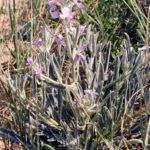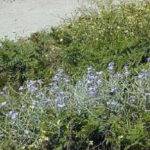A new educational display of the extinct Irish ‘Sea Stock’ is being established at the National Botanic Gardens as part of its native plant conservation and education programme on the threatened flora of Ireland.
In 2006 the National Botanic Gardens initiated a conservation project on the Sea Stock (Matthiola sinuata, Tonóg chladaigh), an extinct plant in Ireland. This week an educational display of seedlings of the species goes on public show in the native plant area of the National Botanic Gardens.
The aims of the NBG project are to:
Establish one or more self-sustaining wild populations of Matthiola sinuata in Ireland at a location where (or near to where) the species formerly occurred.
Raise public awareness of the threats to native plant diversity by using this species as a high profile project in plant conservation.
The project forms part of a new Irish Threatened Plants Programme being undertaken by the National Botanic Gardens. The programme is a response by the National Botanic Gardens to an Irish Plant Conservation Strategy developed in 2005 that seeks to address Ireland’s obligations under the Global Strategy for Plant Conservation, adopted by the U.N. Convention on Biological Diversity in 2002.
The reason for the disappearance of M. sinuata from Ireland is not known. It may be in part because it is at the limit of its climatic limit (in Europe it is a species of southern and western coasts) but disturbance of its habitat may also be a factor. The species is known to be declining throughout its range.
In Britain M. sinuata is now also a very rare plant, with a few plants only each year at two or three sites on the western coasts where it is threatened by the disappearance of sand-dunes, and disturbance by beach visitors. It is a European endemic species, which outside Ireland and Britain is confined to Mediterranean and south-west Atlantic coasts. M. sinuata was first recorded in Ireland in 1804 by Walter Wade, one of the founding fathers of the National Botanic Gardens.
It was formerly recorded from nine Irish sites, 2 in Kerry, 2 in Clare, 1 in Galway and 4 in Wexford. The Irish Red Data Book lists the species as Extinct in Ireland. There have been no records of this species in Ireland since the late 1930s.
Sea Stock is a biennial or short-lived perennial crucifer with pale lilac flowers with four petals, with a faint scent. Its leaves and stems are covered with a thick grey down and it is closely related to the common garden Stock (Matthiola incana).
In the UK the species is restricted to coastal dunes where it grows on open, mobile sand, typically in communities containing Marram Grass (Ammophila arenaria), Sea Holly (Eryngium maritimum), Sea Bindweed (Calystegia soldanella), and Sea Spurge (Euphorbia paralias).
Disturbance and loss of habitat was probably the most important factor impacting on the species in Ireland. The species may be close to a climatic limit in Ireland and any increase of disturbance and/or reduction in recruitment of seedlings into the population could have had a major detrimental impact on the populations in Ireland.
Open, mobile sand is an essential habitat requirement and large populations of this species can survive only on systems that exhibit dynamic sand accretion. Large areas of fixed dune are not likely to be suitable sites for reintroduction. It is hoped that suitable sites for the reintroduction of the plant to the wild in Ireland can be identified in 2006 or 2007.
The plants on display at the National Botanic Gardens have been grown from seed from wild material collected in Britain, cultivated at the Bristol University Botanic Gardens.


